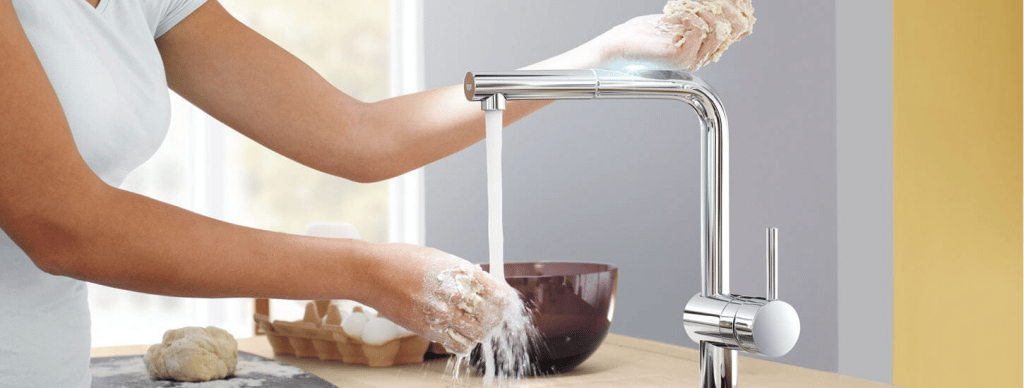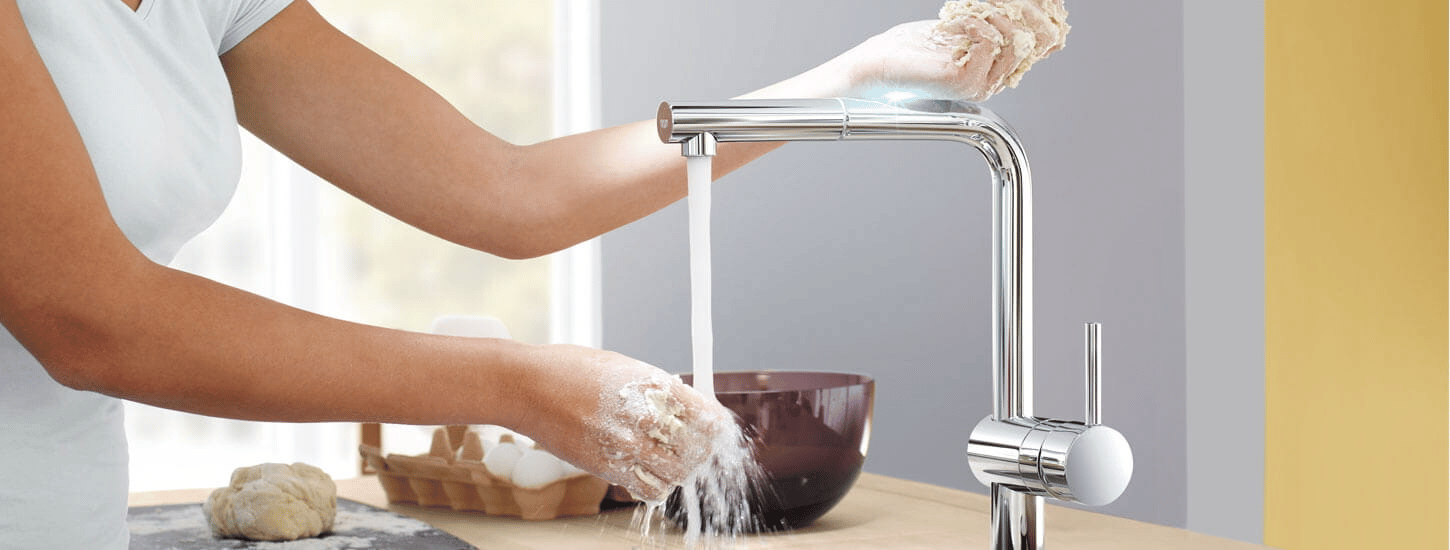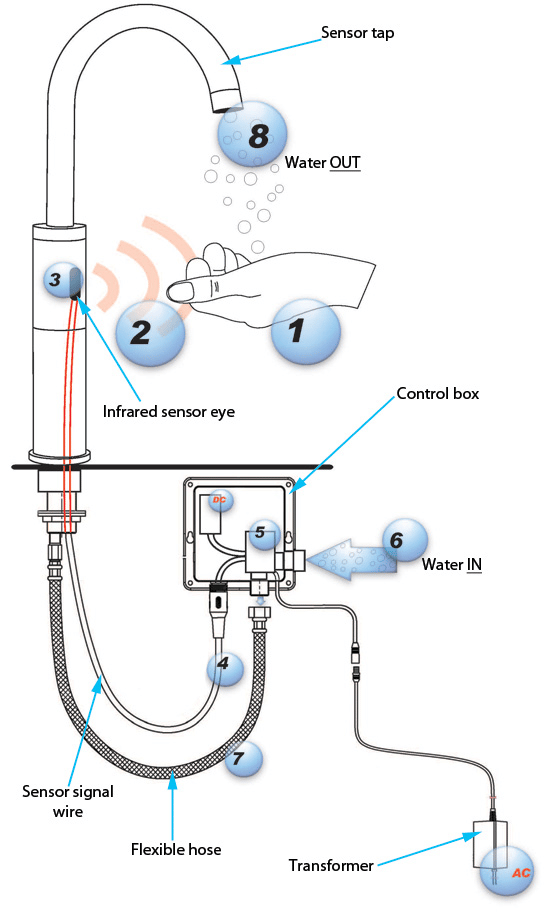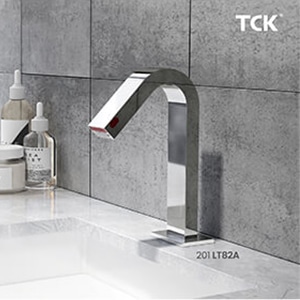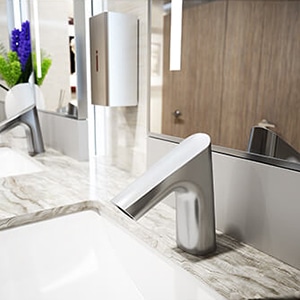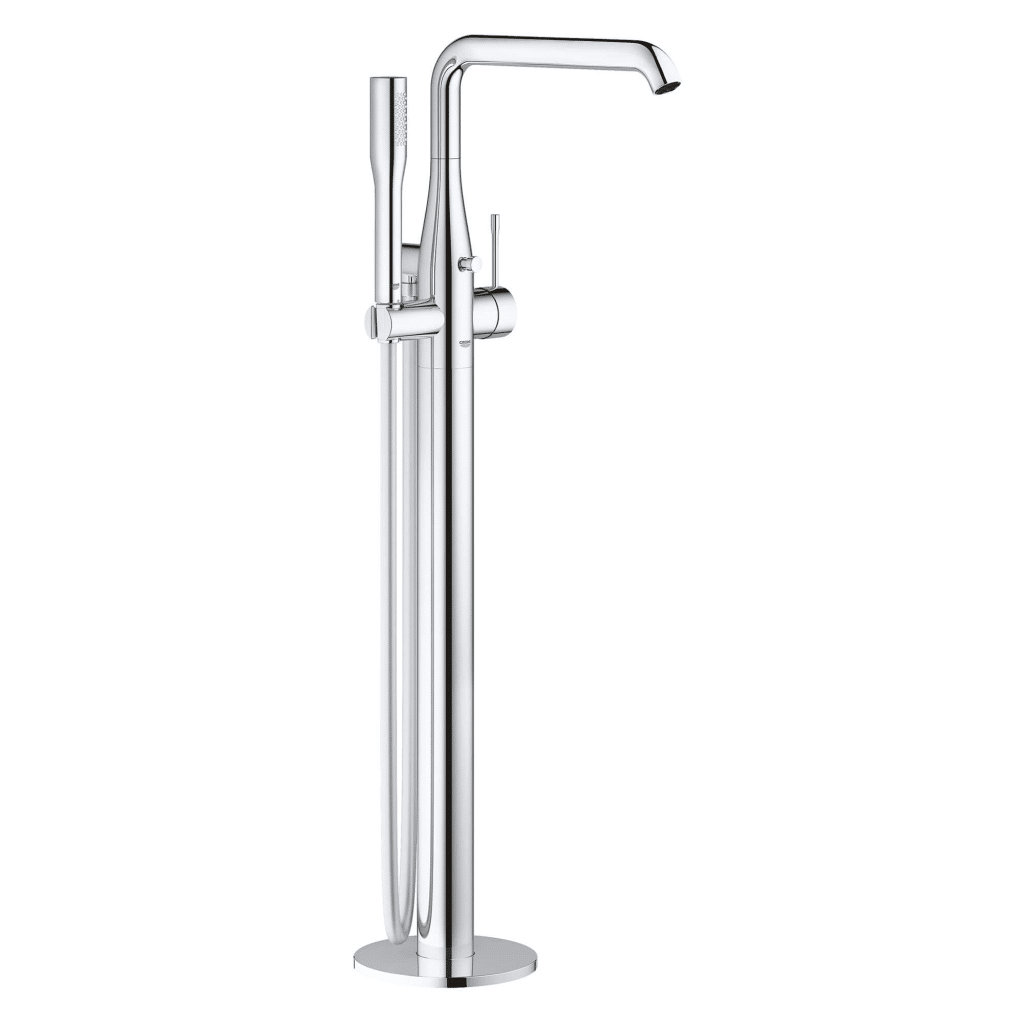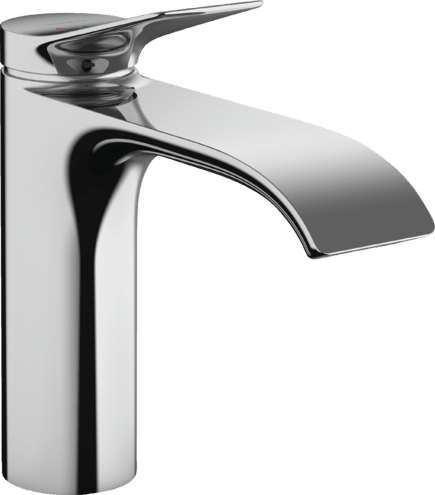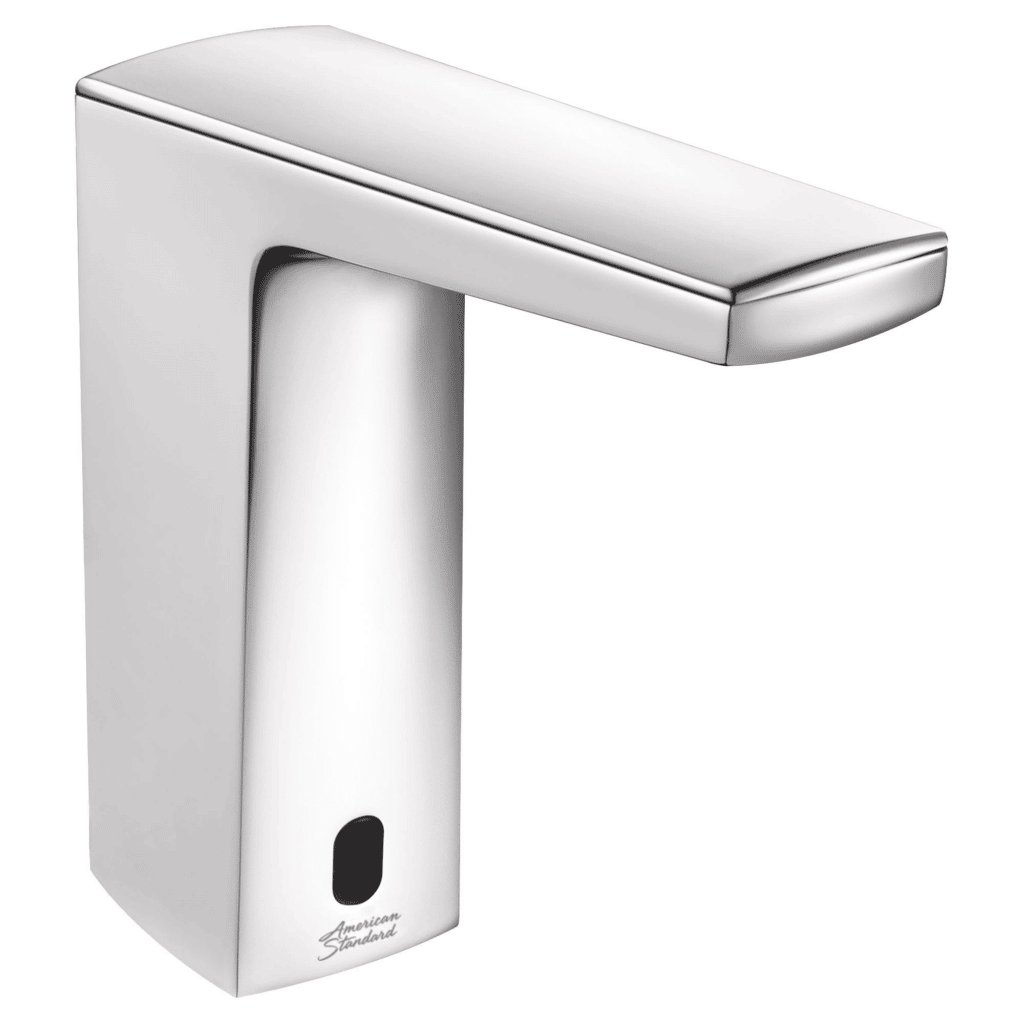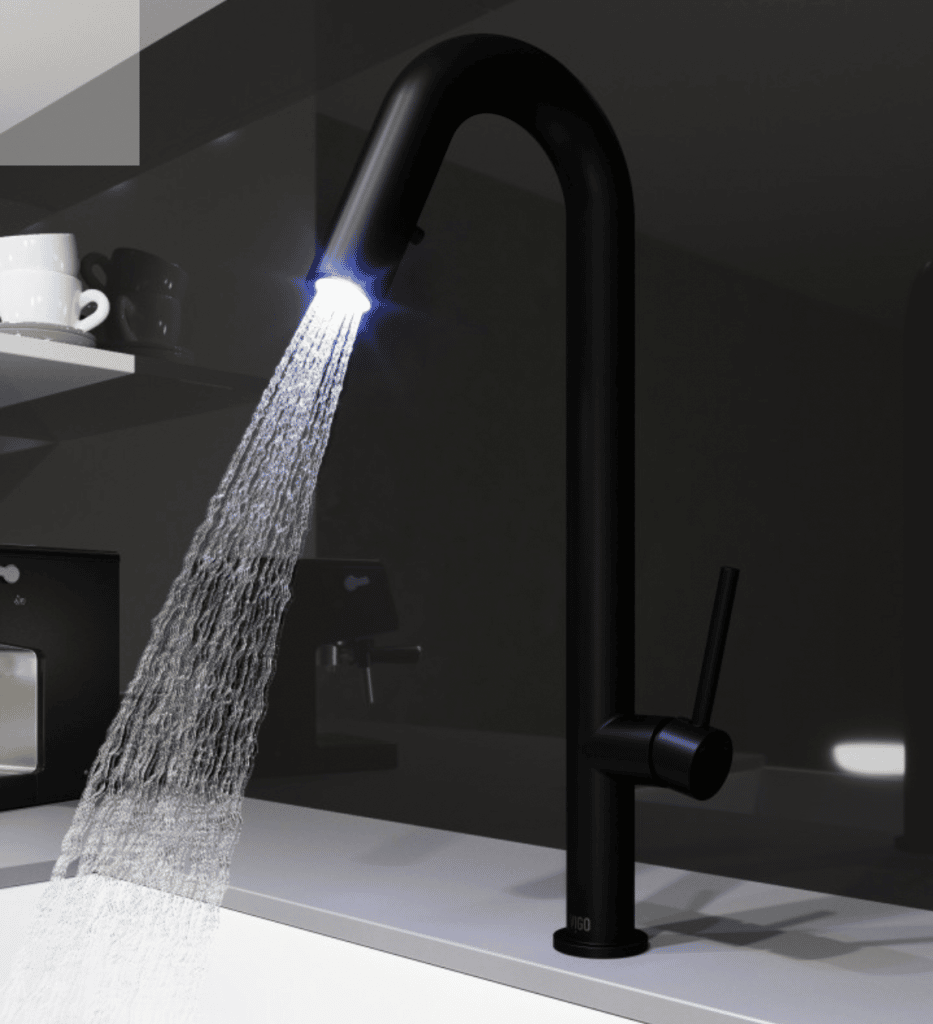Image Source: Grohe
What is a Sensor Auto Faucet?
Sensor faucet taps are automatic taps that turn on and off when hands are detected in the hand-washing area, eliminating the need for the user to manually operate the tap.
When using a sensor tap, the water flow is shut off when the user removes their hands from the sink for hand washing.
Touch vs. Touchless Faucet
When remodeling your kitchen, there are a variety of sink and faucet alternatives to take into account. You might forget about less common choices including touch as well as touchless faucets. Faucets with touch and touchless technology are more than just fun or unusual kitchen accessories. They can help you save water, make using the sink more practical, and maintain your things tidy and germ-free. In addition, since both types of faucets are typically luxury solutions, both sorts are extremely inventive and also aesthetically pleasing.
Touch Faucet
Touch faucets contain sensors in the handle and spout that enable you to tap the faucet to start the flow of water. These faucets offer manual settings in addition to the quick touch operation that can be accomplished with a hand, finger or forearm. Furthermore, some touch faucets have an automated shutoff feature that occurs after a certain amount of time.
Touchless Faucet
A touchless faucet is one that has a proximity sensor and a mechanism that activates when a user’s hands are in close contact and opens its valve to let water flow. They are also called touchless faucet, hands-free faucet, motion-sensing faucet, electronic faucet, infrared faucet or sensor faucets.
What’s the Differences Between Touch Faucets and Touchless Faucets
Both touch and touchless kitchen faucets are excellent options to take into consideration if you’re wanting to upgrade your current model, but you could discover that one that is a perfect fit for your needs.
Touch Faucets
-
Accessibility
Touch kitchen faucets are an excellent method to make sinks accessible to those with mobility issues, retirees, and kids. Many of them shut off automatically, and they don’t need long reaches or fine motor skills to operate.
-
Water Conservation
The somewhat higher electrical cost of a touch kitchen faucet compared to a conventional one is typically more than offset by water conservation.
-
Cleaner Surfaces
A touch faucet will occasionally need cleaning, but not nearly as frequently as a regular faucet. You can cleanse your hands without spreading germs thanks to the trustworthy sensor.
Touchless Faucets
-
Accessibility
As there is no need for a handle with a sensor-equipped faucet, it may be more accessible than a conventional one. Touchless faucets may be surprisingly easy to use for people with arthritis, hand injuries, or other issues.
-
Water Conservation
Compared to standard kitchen faucets, these types of faucets let you save a lot of water. Like touch-sensitive faucets, touchless faucets are more environmentally sustainable and feature lower flow rates.
-
Cleaner Surfaces
Since you won’t need to touch the faucet, it will remain cleaner for a longer period of time. Additionally, by preventing the spread of germs to a handle that might be touched by numerous people in your home or place of business, this is safer and more hygienic.
Are Touchless Faucets More Reliable?
The genuine answer is yes. Touchless sensors, like other sensors, can detect infrared lights in a dark environment by reflecting your hands’ light. This response enables you to ensure that your motions are genuine and aren’t being held motionless against your will.
Can a Touchless Faucet Work Manually?
Yes, both touchless and touch-on faucets can be operated manually. Touch faucets contain sensors in the handle and spout that let you turn the faucet on and off. These faucets offer manual modes in addition to quick touch controls that can be used with a finger, forearm, or hand.
Are Motion Sensor Faucets Worth It: Sensor Taps Pros vs. Sensor tap Cons
Automatic Taps with Sensor Deserve It
Automatic taps helps you conserve water at home. It is called as a “smart nozzle” for it can detect your hand once you place them under the nozzle.
It’s also easy to install and can be adjusted. Find out more through this video:
Benefits of Touchless Faucets: Why they are Greater than the Disadvantages?
Touchless faucets are the best option when you want water on demand without any mess. Because it gives the user more control, some individuals favor touch faucets. When you have to contact the faucet rather than simply move your hand in front of it to turn it on or off, you are less likely to do so unintentionally.
Touch-free Taps
A touchless faucet sometimes referred to as “touch-free,” is operated by a quick hand swipe. The sensor alerts the valve to open and let water flow through the spout when it notices movement.
Automatic Faucet Control
A tiny infrared light and an infrared detector are both included on automatic faucet sensors. When your hands are a few inches away from the lip of the spout, the sensor activates the faucet valve and signals it to turn on.
Sensor for Water Tap
A sensor’s infrared beam is used to control sensor taps (usually located on the stem). When hands are put in front of the beam, water starts to flow. After that, the water runs for a certain amount of time before shutting off automatically.
Disadvantages of Sensor Taps: They Exist but Don’t Cause as Much Impact as the Benefits
Electric-operated, Which means Power was Needed.
Infrared taps occasionally lose their responsiveness; in this case, new batteries are usually required. Sometimes, misleading signals from reflected light might cause the sensor in a touchless tap to activate.
Additionally, because light reflected from hi-viz jackets can mistakenly trigger electronic taps, industrial buildings where hi-viz jackets are frequently worn might not be the best site for them.
Sensor Tap Costs
Although a sensor faucet’s pricing is affordable, it typically requires a larger upfront expenditure than conventional taps. Budget-conscious people can find it challenging, but over time, a sensor faucet ends up saving more money.
It is not advised for people who occasionally need to move out of the house because its considerable cost-saving potential won’t be realized for years after use.
What is used in Sensor Taps?
Image Source: Slide Player
Smart Tap Nozzle
A smart tap nozzle works like a filter, dividing a single, bulbous jet of water into numerous little streams and then directing air into the flow of water.
Wash Basin Tap Aerator
A spherical accessory that you can screw into the tip of your faucet to produce a splash-free stream of water. The stream is typically made smoother by aerators.
Faucet Spout
Its’s the component that transfers water from the body to the sink, and it may have a unique appearance. Long reach and low profile are both features of a straight spout.
Motion Sensors
The sensor alerts the valve to movement so that it can turn on the faucet. Based on the presence or lack of movement, it informs the valve when to initiate or stop the water.
Tap Sensor Light
A bottom-mounted infrared sensor beam is used to organize sensor taps. When your hands are in front of this beam, it breaks, releasing water from the tap.
Sensor Tap Battery
Faucet sensor is powered by batteries and activates when it notices movement. If the sensor detects no movement after 10 seconds, the water flow stops, which helps save water waste.
How do Sensor Taps Work: Sensor Tap Mechanism
Diagram
Image Source: Electronic Sensor Taps Manufacturer
Do Sensor Taps Need Power?
If you are asking if do touch faucets need electricity, the answer is yes. Whether via a battery or a transformer, the electronic sensor tap needs to be powered.
The sensor can find an object, such as a hand in front of the sink faucet, if there is energy supply. When an obstacle is detected, the solenoid valve opens.
Sensor Tap Mechanism
If you are at home, wondering how these incredible sensor tap faucets work, well you don’t need to look further. Here is a step-by-step guide for you:
- Power, whether from a transformer or a battery, is required for the sensor tap system.
- When there is energy available, the sensor can pick up objects like a hand in front of the sink faucet.
- When an obstacle is felt, the solenoid valve opens.
- Water pours through the spout and pipe in this manner.
- This gadget sends the appropriate signal when there is no item in front of the sensor.
- The solenoid valve then closes.
- The water also stops flowing.
Common Sensor Tap not Working Issues
Low Battery
The presence of a battery pack on a touch faucet distinguishes it from a normal one. The faucet won’t function as effectively as the batteries begin to run low, as you might expect. LED lights that alert you to low battery are included on the majority of touch faucets.
For Moen faucets not working issues, make sure the power supply cable (battery pack or AC adapter) and the data cable are plugged in firmly and securely.
Outdated Solenoid Valve
To turn the faucet on and off, a solenoid valve and touch sensor are used. It could be necessary to reset or replace the valve if it is worn out since it will not push or pull as effectively as it should.
The solenoid valve, which is connected to the battery pack, is located underneath the sink. It takes some electrical expertise to replace the solenoid. For Tuscany faucets, it might be best to let a specialist handle this situation as you’re dealing with energy and water.
Water Flow Is Low
Similar to a regular faucet, the faucet aerator should be checked first when there is insufficient water flow. This little metal disc inside the faucet gives the stream of water air bubbles, which saves water while giving you the impression of high pressure.
The aerator, however, may eventually get clogged with trash or mineral deposits. Consider taking the aerator out, soaking it in vinegar, washing it, then putting it back in.
#1 Touch/Touchless Faucet not Working Reason: Flashing Red Light
With typical use, ordinary batteries can last up to two years. When the batteries need to be changed, the LED indicator light on the faucet’s base will begin to flicker red. The faucet can still be used manually if the batteries are not changed on time.
Low batteries are indicated by a red flashing sensor light on the Malleco or Barossa Touchless Kitchen Faucets. If the sensor light flashes red, the batteries need to be changed.
While changing the batteries, forcefully press the batteries in until they are touching the contacts and fully inserted. The connection from the battery box should be secure, so check the valve control one more time.
#2 Touch/Touchless Faucet Stopped Working Reason: Motionsense Faucet Won’t Turn on or Off
If your faucet drips or won’t stop running, it may be faulty, in need of a solenoid repair, or it may just need a good cleaning. However, you can make a call to your faucet’s brand Customer Service if this doesn’t work. They could have a spare part on hand.
Use a test light to look for leaks near the faucet and under the sink to determine when the faucet is broken or cannot be operated with a replacement cartridge. The washer on your faucet must first be taken out.
Next, squeeze the handle. Replace the cartridge if it is completely immobile. Before buying a new cartridge, make sure there aren’t any additional problems, including blocked filters or broken pipes.
#3 Touch/Touchless Faucet Stopped Working Reason: No Water Coming out of the Faucet
The batteries might need to be changed if the LED sensor flashes but there is no water flowing from the faucet. The light on some touchless faucet types will flash five times every four seconds to let you know the batteries need to be replaced, so do that first.
A flashing light, however, might also be a sign of a sensor or sensor cable short. Carefully remove the washer’s black sensor wire, then contact it with your finger. As soon as you quit touching the wire, the water flow should stop.
If so, the cover plate installation and the spout are at fault. If not, there may be a problem with the sensor wire’s integrity or with the grounding.
#4 Touch/Touchless Faucet Stopped Working Reason: Faucet not Flowing Properly
If there is a slow water flow from the faucet, the water supply valve might not be completely open. If this is the case, simply adjust the valve. The aerator can be clogged, in which case it needs to be taken out and cleaned to have the water flowing normally again.
Also possible is a clogged solenoid filter. You could need a replacement solenoid filter kit if removing and cleaning it does not fix the issue, though.
Unscrew the nozzle to inspect for a damaged or improperly positioned washer in order to correct this. The next thing you might notice is dust and mineral fragments gathered at the screen. Rinse everything thoroughly. Check that the water valves under the sink are completely open if that doesn’t boost the flow.
Sensor Tap Installation: How to Install Sensor Top Fitting
1. Turn off the main water valve by finding it and turning it off.
2. Gently remove the tap from the sink and the plumbing in your house.
3 Insert your new sensor tap into the basin’s mounting hole, along with its inlet pipe and sensor wire.
4. The sensor line from your tap should now be connected to the controller box.
5. Now that everything is safely linked up, it’s time to test the tap.
How Much to Change Basin Taps
Sensor Tap Cost
The prices are truly fair enough. Upon research, Alibaba, Alie Express and Amazon will only price you from $28 to $60 for every basin replacement depending on faucet’s size, style and functions. Shipping process and rates usually depends on the courier and the weight of the product you ordered.
How Much to Change Bathroom Faucet
You might be thinking how much the installation would cost you if you need to replace a bathtub, kitchen, or bathroom faucet. Most homeowners spend around $250 for faucets.
- Installing a new faucet or replacing an old one typically costs between $120 and $300. This includes changing out the old faucet and making any necessary changes to the water pipes.
- This does not include the price of the replacement faucet, which can run anywhere between $100 and $350.
Cost to Replace Kitchen Sink Faucet
Installing a kitchen faucet normally costs between $160 and $345, but depending on a number of circumstances, the price might be as low as $90 or as high as $585. The price varies from brand, size, style and functions.
For instance, you’ll have to pay labor fees in addition to the cost of the faucet if you hire an expert to install and replace the kitchen faucet rather than doing it yourself.
Which Faucets are the Best Quality?
Automatic Faucets with Sensor (Sensor Tap)
TCK have always been your partner when it comes to bringing you to a place where convenience speaks up. You can use this touchless automatic faucet for the bathroom, kitchen, stall, or lavatory whether it is for personal or professional use.
Additionally, sensor faucets for sinks, washbasins, vanities, showers, and bars makes your life more easier upon its activation.
Grohe Sensor Faucet
Have a faucet that are extremely environmentally friendly and could make your life easier than ever!
The most cutting-edge feature of GROHE Touch faucets is something you’ll fall in love with it after just one touch. It is a German faucet brand .
GROHE Touchless FootControl faucets can be tapped by your toe on the base unit, freeing up your hands from stress. It’s simpler than ever to fill large pots, wash dishes or your hands, and keep the tap clean and gleaming.
Grohe Infrared Tap
Image Source: Grohe
Infrared sensor-controlled automatic taps are a fantastic choice for hand washing and dishwashing since they can help you avoid germ-spread. Learn the common Grohe faucets not working concerns before you decide to purchase this brand faucet.
Grohe Hands Free Faucet
Image Source: Grohe
GROHE SilkMove handles are ideal for effortless, fluid handling. It ensures that all hand shower nozzles have an even water flow.
Moen Sensor Faucet
Moen is a faucet made in the USA
Moen Touchless Kitchen Faucet
Image Source: Moen
Aerated stream are great for general cleaning, boosted stream and forceful rinse. The lever grip makes it simple to change the water. Learn the common moen faucets not working concerns before you decide to purchase this brand faucet.
Moen Touchless Bathroom Faucet
Image Source: Moen
The aerated flow is great for brushing teeth and washing hands. And, one-handle lever makes adjusting the water pressure simple.
Kohler Sensor Tap
Kohler is also a faucet manufacturers in usa
Kohler Wash Basin Sensor Taps
Image Source: Kohler
Aside from being easy to use, its ceramic disc valves provide lifelong enduring performance by exceeding industry durability criteria by two times. Learn the common Kohler not working concerns before you decide to purchase this brand faucet.
Hansgrohe Faucets
Hansgrohe is one of the European faucet brands
Hansgrohe Black Taps
Image Source: Hansgrohe
Can adjust temperature and has a maximum flow rate at 3 bar. It’s also appropriate for continuously operating water heaters.
Delta Sensor Faucets
Delta is an automatic faucet assembled by faucet manufacturers in USA and Canadian faucet manufacturers.
Delta Automatic Faucets
Image Source: Delta
Provides you convenience by letting you put your hands near the faucet. After two minutes, the water flow automatically stops to conserve water. Learn the common Delta not working concerns before you decide to purchase this brand faucet.
American Standard Automatic Faucet
Image Source: American Standard
The faucet mounts from the top, making installation and maintenance simple. It also includes twin inlets for hot and cold water.
Pfister Raya Faucet
According to reviews, Pfister faucets are made by contract factories in China and Korea.
Image Source: Lowes
The pull-down spray spout has stream, spray, and pause options. Multitasking is simple because to the lever handle’s convenient one-handed usage.
Image Source: Vigo
LED white light activates while the faucet is in operation. The elegant pull-down spout allows you to wipe the sink and dishes.
Recommended Sensor Tap Manufacturers
With its high standard custom faucet design and production capabilities both domestically and internationally, TCK electronic faucets has established a solid reputation as the industry leader. The company approaches science and technology with a people-oriented orientation, with Certifications: ISO 9001.
It is also a famous manufacturer with OEM faucet service has more than 20 years of experience in the faucet industry. Their faucets are built of rust-resistant, environmentally friendly raw materials, which can guarantee the safety of your water.
Conclusion
Touch and touchless faucets can both be substantial improvements over a standard faucet. Because people have diverse opinions about which is best, both options are available.
Touchless faucets are the best option if you want clean, on-demand water. But a touch faucet is the perfect choice for you if you want a faucet that gives you total control while you’re doing your duties.
Now, all you have to keep in mind is what works best for your local location. To make a decision with ease, take into account the information above.
